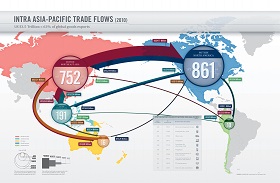Interview
The APEC Summit in Vladivostok in 2012 was supposed to become the forerunner of a more active economic integration in the Asia-Pacific region. However, realizing this strategy on a tactical level turned out to be a difficult task. In an interview to RIAC Program Coordinator Anton Tsvetov, Member of the Deutsche Bank Russia Management Board and Chief Economist Yaroslav Lissovolik shares insights on the reasons for these difficulties and ways to promote Russian business in East Asia.
Interview
The APEC Summit in Vladivostok in 2012 was supposed to become the forerunner of a more active economic integration in the Asia-Pacific region. However, realizing this strategy on a tactical level turned out to be a difficult task. In an interview to RIAC Program Coordinator Anton Tsvetov, Member of the Deutsche Bank Russia Management Board and Chief Economist Yaroslav Lissovolik shares insights on the reasons for these difficulties and ways to promote Russian business in East Asia.
Mr. Lissovolik, how do you assess the economic cooperation between Russia and the Asia-Pacific countries in terms of quantity and quality?
Of course, we can state with certainty that Russia’s interaction with Asia-Pacific region is far from what it should be. For Russia increasing trade with these countries is a factor of development and unlocking enormous economic potential of the Russian Far East and Siberia. It is an opportunity to reorient its economy towards fast-growing countries (which will expand and diversify our exports), to promote investment cooperation with the region, which has the greatest pool of savings in the world. The potential of Russian economic cooperation with Asia-Pacific countries is really high. This is true for the Asia-Pacific sub-regions, for trade with Japan and ASEAN countries. In terms of growth and trade interaction dynamics, there have been signs of changing the situation for the better in recent years, but so far the share of Asia-Pacific in Russia's foreign trade is not big enough yet. This is partly due to the fact that over the past decades, our foreign economic and trade policy was overly Euro-oriented. Against the background of economic downturn and crisis in Europe, the recovery from which can take a long time, Russia's efforts to reorient trade investment flows towards more dynamic regions of the world economy, Asia Pacific in particular, are quite natural.
You have mentioned some positive dynamics in the development of economic relations between Russia and the countries of East Asia. However, it is clear that the changes for the better are not fast enough. What accounts for it, in your opinion?
I believe this is due to a number of reasons. In part, there is inertia. For a long time we have tried to get through to Europe, expecting a more intense interaction, and often failing to get it in response to our steps, liberalizing trade. The reorientation of trade towards Asia requires certain measures of infrastructural development too. If we are talking about cooperation in the energy sector, it is clear that the rapid growth of Russian exports to the Asia-Pacific region should be preceded by an active development of pipeline network and the entire infrastructure of energy supply. It requires a fairly large expenditure of time, effort, and finances. Another factor is insufficient efficiency and qualification of our economic diplomacy. A substantial shift in orientation “from the West to the East” requires from our economic diplomacy more energetic efforts in concluding economic alliances at the level of separate companies and regions. In their addresses to the Russian diplomatic corps, Dmitry Medvedev and Vladimir Putin have been sending this message more than once over the past few years.
As to the positions of our business in Asia Pacific, we can speak mostly about large state corporations. What prevents private companies, including medium-sized ones, from penetrating into this region and actively working there?
In my opinion, on the one hand, this reflects large-scale problems of small and medium-sized businesses in Russia, and on the other hand – indicates low dynamics of development of this segment of our economy, which, in turn, results from high administrative barriers and not very favorable investment and economic conditions in general. Such countries as Australia give us an example of another factor. These countries demonstrate a very successful experience of export expansion in the Asia-Pacific region due to small and medium enterprises through effective state support of the latter in the sphere of export operations. Here the important components are efficient economic diplomacy and public policy, aimed at reducing informational and infrastructural barriers for small and medium-sized businesses, rendering private entrepreneurs assistance in finding contractors and establishing joint ventures. In recent years, Russia has intensified its activity to this end, including the efforts of its Ministry of Economic Development, and we see some progress in this direction. However, the “mentality of gigantomania” continues to dominate, and it is still assumed that the breakthroughs and improved economic indicators are better achieved with the help of large companies.
Speaking about the geographical distribution of economic ties between Russia and Asian countries, we can see some imbalance in favor of China. Do you consider this a natural phenomenon? Do we need to correct the situation?
I believe that active efforts to correct this imbalance by government regulatory actions, associated with protectionism, are counterproductive. In many ways, the increased role of China in our market reflects global trends and the economic position of China in the Asia-Pacific region and Russia’s economic and political considerations. Therefore, if we follow different economic models that predict trade flows, based on the geographic proximity of a country and its economic might, the increased role of China is quite natural and should be expected. What has to be done to enhance cooperation with other countries in the region should be rather associated with a more active policy, pursued by these countries in relation to Russia, and by Russia – to these countries. The greatest potential, to my mind, lies in promoting cooperation with South Korea, the ASEAN countries, possibly with New Zealand and Australia, especially given the fact, that Russia is negotiating a foreign trade zone with the countries of the region. In my opinion, free trade areas offer a very important instrument that Russia could use to attract both investment and trade flows. In this regard, there has been achieved some progress in relations with New Zealand and Vietnam.
In economic cooperation with ASEAN, Russia has a competitive advantage in such traditional industries, as nuclear energy and military-technical sphere. How prominent is Russia's leadership in these sectors? We know that South Korea is also very active in exporting services for construction and maintenance of plants.
In my opinion, we should look for opportunities to improve competitiveness in the areas where our interests may clash with those of some countries in Asia Pacific. This competitive face-off may be smoothed over by creating strategic alliances at the enterprise level, or at the level of industries and countries. Generally speaking, this instrument is of micro-level nature. Being associated with strategic partnership and alliances, it involves companies in the region and can raise the investment yield and improve technological interaction. Russia has to promote foreign investment too. In April 2013, Deutsche Bank issued a report Russia's Outward FDI: In Search of New Paradigm, which analyzed trends and possibilities, relating to foreign investments of Russian companies. The main conclusion the report makes is that Russia’s investment is extremely unproductive in many ways. Improving efficiency in this area could make foreign investments an effective tool in promoting the country’s competitiveness and interaction with foreign companies. We cannot afford being complacent in relation to the industries that have traditionally ensured us a decent place in the world market, since new players emerge that are much more efficient in using the entire arsenal of foreign policy to enhance their competitiveness.
Do you believe that engaging in Track II diplomacy at the expert level can promote Russia's economic interests in the Asia-Pacific region? Does the domestic business need the support of experts?
Definitely, yes. Again, I can state that there have been positive developments in this area. An ASEAN Studies Centre has been established at MGIMO-University, business councils and business forums Russia-ASEAN and Russia-Indonesia are under creation. In other words, this process is really gaining momentum, and the level of expert support and interaction between expert centers and the business community is growing. Of course, we are still very far from the level of cooperation between experts and the private sector that we see in Western countries, where this mechanism has been fine-tuned for decades and works in close liaison with partners in the Asia Pacific region. However, in recent years we witness the growing number of publications on economic cooperation between Russia and the countries of East Asia, as well as intensified contacts between analytic centers in Russia and the Asia Pacific region.





